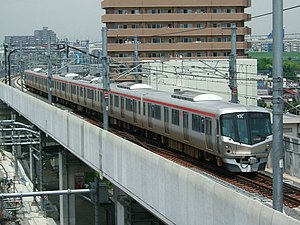Tsukuba Express
| Tsukuba Express | |
|---|---|
 A Tsukuba Express train (TX-2000 series) | |
| Overview | |
| Owner | Metropolitan Intercity Railway Company |
| Locale | Kanto Region |
| Termini | |
| Stations | 20 |
| Service | |
| Type | Commuter rail |
| Depot(s) | Moriya |
| Rolling stock | TX-1000 series / TX-2000 series |
| History | |
| Opened | 24 August 2005 |
| Technical | |
| Line length | 58.3 km |
| Track gauge | 1067 |
| Operating speed | 130 km/h (80 mph)* |
Template:BS5 Template:BS3 Template:BS3 Template:BS3 Template:BS3 Template:BS3 Template:BS3 Template:BS Template:BS3 Template:BS5 Template:BS3 Template:BS3 Template:BS3 Template:BS5 Template:BS5 Template:BS5 Template:BS5 Template:BS5 Template:BS5 Template:BS5 Template:BS5 Template:BS5 Template:BS5 Template:BS Template:BS Template:BS Template:BS Template:BS Template:BS Template:BS Template:BS Template:BS Template:BS3 Template:BS3 Template:BS Template:BS Template:BS3 Template:BS Template:BS Template:BS Template:BS3 Template:BS3 Template:BS Template:BS Template:BS Template:BS Template:BS Template:BS Template:BS Template:BS Template:BS Template:BS
|}
The Tsukuba Express (つくばエクスプレス線, Tsukuba Ekusupuresu-sen), or TX, is a Japanese railway line of the Metropolitan Intercity Railway Company which links Akihabara Station in Chiyoda, Tokyo and Tsukuba Station in Tsukuba, Ibaraki. The route was inaugurated on August 24, 2005.
Speed
The line has a top speed of 130 km/h. Rapid service has reduced the time required for the trip from Akihabara to Tsukuba from the previous 1 hour 30 minutes (by the Jōban Line, arriving in Tsuchiura, about 15 km from Tsukuba) or 70 minutes (by bus, under optimal traffic conditions) to 45 minutes; from Tokyo, the trip requires 50 – 55 minutes. The line has no grade crossings.
An automatic train operation system allows a single individual to operate the train.
Electrification and rolling stock
To prevent interference with the geomagnetic measurements of the Japan Meteorological Agency at its laboratory in Yasato, Niihari District, Ibaraki, the portion of the line from Moriya to Tsukuba operates on alternating current. For this reason, the trains include TX-1000 series DC-only trains, which can operate only between Akihabara and Moriya, and TX-2000 series dual-voltage AC/DC trains, which can operate over the entire line.
Volume production of the rolling stock began in January 2004, following the completion in March 2003 of two (TX-1000 and TX-2000 series) six-car trains for trial operation and training. The full fleet of 84 TX-1000s (14 six-car trains) and 96 TX-2000s (16 six-car trains) was delivered by January 2005.
Stations
- ● L: Local (普通, Futsū)
- ● S: Semi-Rapid (区間快速, Kukan kaisoku)
- ● R: Rapid (快速, Kaisoku)
All trains stop at stations marked "●" and pass stations marked "-". Some local trains stop at "▲".
History

Initially, the line was to be called Jōban Shinsen (New Jōban Line). The reason for the line was to relieve crowding on the Jōban Line of East Japan Railway Company (JR East), which had reached the limit of its capacity. However, with the economic downturn in Japan, the goal shifted to development along the line. Also, the initial plan called for a line from Tokyo to Moriya, but expenses forced the planners to start the line at Akihabara instead of Tokyo, and pressure from the government of Ibaraki Prefecture resulted in moving the extension from Moriya to Tsukuba into Phase I of the construction.
The original schedule called for the line to begin operating in 2000, but delays resulted in a 2005 start.
From the start of the revised timetable on 15 October 2012, new "Commuter rapid" (通勤快速, tsūkin kaisoku) services are due to be introduced in the morning (up services) and evening (down services) peak periods.[1]
Ridership figures
| Fiscal Year | Total number of passengers carried | Days operated | Passengers per day |
|---|---|---|---|
| 2005 | 34.69 million | 220 | 150,000 |
| 2006 | 70.69 million | 365 | 195,000 |
| 2007 | 84.85 million | 366 | 234,000 |
(Source: [2])
See also
List of railway companies in Japan
References
- ^ "10月15日(月)にダイヤ改正を実施いたします。". News Release (in Japanese). Japan: Metropolitan Intercity Railway Company. 26 July 2012. Retrieved 30 July 2012.
{{cite web}}: Unknown parameter|trans_title=ignored (|trans-title=suggested) (help) - ^ "開業3周年を迎えるつくばエクスプレス(TX)" (Tsukuba Express Celebrates its 3rd Anniversary). Tetsudō Daiya Jōhō Magazine, August 2008 issue, p.63
